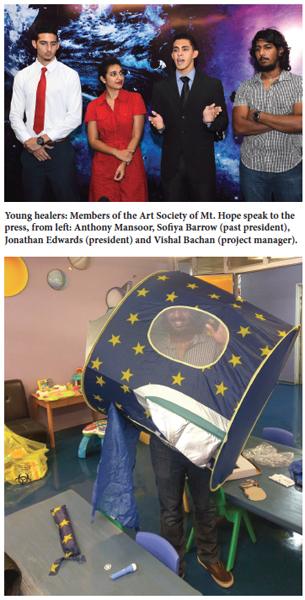
A hospital ward is not a fun place, especially for children. At the pediatric ward of the Eric Williams Medical Sciences Complex in Mt. Hope, however, a group of UWI students have selflessly donated their time, effort and creativity to bring joy into the lives of the young patients. They have transformed one of the wards into a fantastical landscape, an otherworldly realm of planets, stars and spaceships for the children’s enjoyment.
They refer to it as the “Star Ward”.
“We did it for the kids. And when we do another ward it will be for the kids again,” says Vishal Bachan, a third-year student in the Faculty of Medical Sciences.
 Vishal is the Project Manager of the Art Society of Mt. Hope, a group of remarkable students from the Medical Faculty who have turned their love for art into flourishing events and charitable acts. The refurbishment of the ward, Paediatric Med 1, is their biggest charitable initiative yet and a testament to their hard work and perseverance. Vishal is the Project Manager of the Art Society of Mt. Hope, a group of remarkable students from the Medical Faculty who have turned their love for art into flourishing events and charitable acts. The refurbishment of the ward, Paediatric Med 1, is their biggest charitable initiative yet and a testament to their hard work and perseverance.
“The ward project was done mainly at nights, on Friday nights or weekend nights,” says Vishal, who describes himself as a “handyman.” The work included cleaning and painting the walls, the installation of custom-made decals, the cleaning of the playroom and redecoration with new tables, new curtains, new toys and the creation of a huge mural occupying an entire wall. It was four nights work in total, from 6pm to 2am, stretched over six weeks because the students had to work around their class and study schedules.
The project was funded entirely by the Art Society, using proceeds from its popular Art Gala and Human Art Project events. In an earlier issue, “UWI TODAY” covered the inspiring story of the Society’s growth from a small student group to hosts of a well-regarded art exhibition that was held this year at the National Academy of the Performing Arts (https://sta.uwi.edu/uwitoday/archive/october_2016/article16.asp).
Apart from the time, labour and resources invested by the students, who also have to contend with their exacting courses of study, the Society had to overcome the many administrative and bureaucratic hurdles involved in the project. Sofiya Barrow, Past President of the Society and one of the major forces behind bringing the project to fruition, said it was a challenge.
“There were so many odds against us and many times people advised me not to waste my tenure trying to make it happen but to do something else with the money. Getting approved for this project was like a shot in the dark.”
The initial idea for the transformation of the ward came from Dr. Srikanth Rao Venkata, founder and first president of the Art Society. It has taken years for it to become reality, finally coming to fruition under current president Jonathan Edwards.
“Each Art Society president played a crucial role in this very long process,” Sofiya says, “from building the Society itself to forming the charity, to funding, to approval and getting organised, to finally executing it.”
Now that the work is complete, the Society members are pleased.
“Renovating this ward has made both Mt. Hope and national history,” Sofiya says. “No other groups in school have ventured to do such a thing on their own.”
The completed project attracted the interest of hospital officials, Medical Faculty members and the media at the grand opening in mid-March. But for Society members like Vishal, it is the children’s response that matters most.
“They loved it,” he said. “When we were working the majority of parents were very supportive and showed great admiration that we were spending the time to do it. The nurses on the ward were especially grateful for the facelift. And they were amazingly accommodating and supportive during this venture.”
Vishal also had some advice for people who wish to make a difference in society, especially at a time when so much seems to be going so wrong:
“Open your eyes and look around, see what is there to be done and do it. Get together with some friends and make your goal a reality. This project took very long before it could be started but we never gave up. It wasn’t easy, it wasn’t cheap and it was difficult to find the time, but we did it. Anyone who wants to do their own project should adopt the same policy. Look at what needs to be done and do it. Because if one child looks at a decal, or one child looks at our mural and smiles, feels better or stops crying, that makes the project worth it.” |





